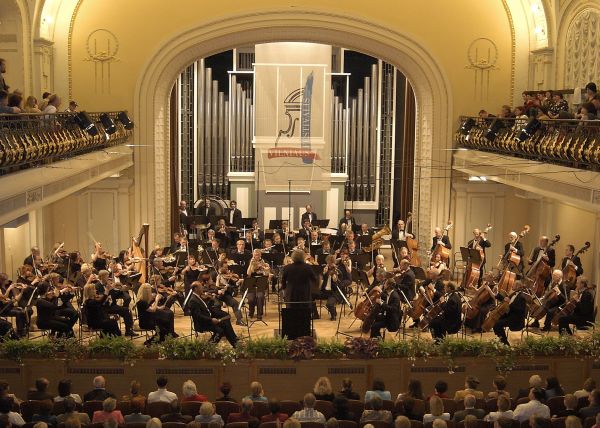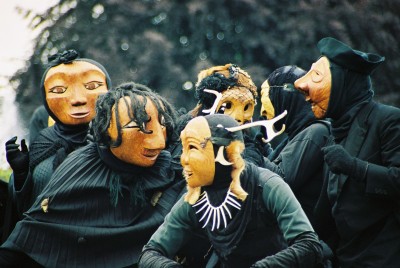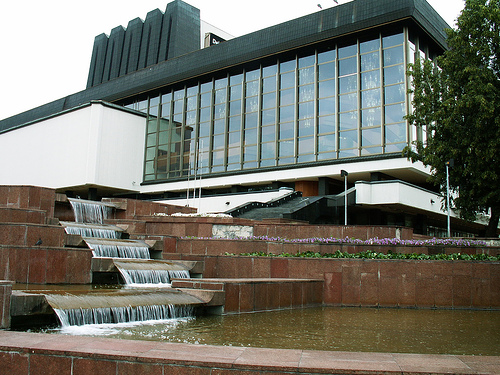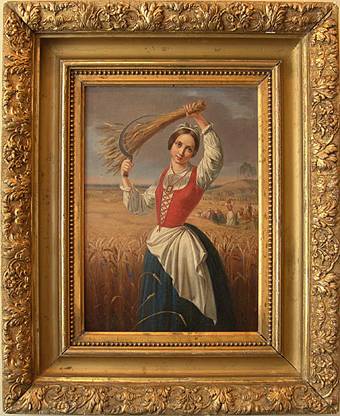
THE VOICE OF INTERNATIONAL LITHUANIA
|
VilNews has its own Google archive! Type a word in the above search box to find any article.
You can also follow us on Facebook. We have two different pages. Click to open and join.
|

The Lithuania National Symphony Orchestra playing in the National Philharmonic Hall, Vilnius.
Conductor: Professor Juozas Domorkas. Photo: Michailo Raškovskio
Far too few people outside Lithuania know what a tremendous treasure of culture this country represents! Today Lithuanian art is not only flourishing at home but is also gaining recognition internationally. Though not every poster tells that a nightingale soprano, a graceful ballerina, or a divine cello player comes from Lithuania, the probability that you have just enjoyed a concert of a Lithuanian artist is great, whether it be New York, London, Berlin, or Vilnius.
Vilnius, a city with a population slightly more than half a million, is packed with art galleries and is full of posters inviting you to exhibitions, concerts and plays, both in traditional galleries and concert halls, but also in less traditional venues. The old town itself is like a spacious and cosy gallery of Baroque architecture.
And it is not only Vilnius that can boast of a rich cultural life. Nearly every bigger town has a professional theatre, concert hall and a tradition of regularly attending cultural events. Though the Lithuanian summer is short, the summer calendar is packed with festivals going on all around Lithuania.
For centuries Lithuania has been home to those of Slavic, Jewish, Karaite, and Prussian descent, along with those of other nations. This multiculturalism, along with the figurative expression in literature, theatre, cinema and fine arts, has become a hallmark of Lithuanian art. The link between history and the present is the feature pointed out most often by lovers of Lithuanian art in neighbouring European countries and more distant Asian countries...

“Užgavėnės” is a Lithuanian festivalthat takes place during the seventh week before Easter (Ash Wednesday). Its name in English means “the time before Lent”. The celebration corresponds to Roman Catholic holiday traditions in other parts of the world, such as Mardi Gras, Shrove Tuesday, and Carneval.
Europe is discovering Lithuania through its culture. Lithuanian art is not only flourishing in Lithuania but is also gaining recognition internationally. Though not every poster tells that a nightingale soprano, a graceful ballerina, or a divine cello player comes from Lithuania, the probability that you have just enjoyed a concert of a Lithuanian artist is great, whether it be New York, London, Berlin, or Vilnius.
Vilnius, a city with a population slightly more than half a million, is packed with art galleries and is full of posters inviting you to exhibitions, concerts and plays, both in traditional galleries and concert halls, but also in less traditional venues. The old town itself is like a spacious and cozy gallery of Baroque architecture.
It is not only Vilnius that can boast of a rich cultural life, but nearly every bigger town has a professional theatre, concert hall and a tradition of regularly attending cultural events. Though the Lithuanian summer is short, the summer calendar is packed with festivals going on all around Lithuania.
For centuries Lithuania has been home to those of Slavic, Jewish, Karaite, and Prussian descent, along with those of other nations. This multiculturalism, along with the figurative expression in literature, theatre, cinema and fine arts, has become a hallmark of Lithuanian art. The link between history and the present is the feature pointed out most often by lovers of Lithuanian art in neighboring European countries and more distant Asian countries. They also point to the tolerance and openness of Lithuania culture towards cultures of other nations.
Literature
Lithuanians are well-read nation. Enthusiastic participation in international book fairs has changed the attitude of foreign publishers towards Lithuanians writers and also of Lithuanians themselves. Earlier the leading role in Lithuanian literature was played by poetry, though international book fairs brought a revelation that should show more interest in and be proud of the modern prose by talented Lithuanian women writers like Jurga Ivanauskaitė, Renata Šerelytė, Vanda Juknaitė and gifted contemporary authors such as Sigitas Parulskis and Marius Ivaškevičius. The most pleasing fact is that despite global computerization, both translations and books by Lithuanian authors still top gift lists, and that the Baltic book fair in Vilnius is attended by nearly every second Lithuanian family.
Theatre
Meanwhile Lithuanian theatre could be called the most intriguing part of the general development of theatre happening worldwide. Moreover, stage directors from Lithuania have a huge following in many parts of the world: Eimuntas Nekrošius is a favorite of Italian drama ad opera theatres, Rimas Tuminas is beloved in the Nordic countries, and the festivals in Avignon and Edinburgh cannot be imagined without Oskaras Koršunovas. Lithuanian theatre performances are always a big event in Russia, and the number of Lithuanian theatre fans is rapidly growing in France, Germany, Italy, Spain, South Korea, Hong Kong, USA, Mexico, Canada, Columbia, Argentina and Brazil.
Opera star Violeta Urmana performs at famous theatres and concert halls all over the world, but few know that this top level soprano is Lithuanian. Similarly successful are other Lithuanian musicians, traveling and performing in concert halls all over the world, and winning awards at international festivals. They are performing not only popular or modern world classics, but also the music by famous Lithuanian composers – Onutė Narbutaitė, Raminta Šerkšnytė, Bronius Kutavičius, Osvaldas Balakauskas, Algirdas Martinaitis, Mindaugas Urbaitis and Anatolijus Šenderovas.

The Lithuanian National Opera and Ballet Theatre invites you to the performance of the 2011 Season . Keeping in mind that all tickets are usually sold out before the performance, we recommend you to book tickets beforehand.
Fine arts
Today exhibition halls show the pieces of fine arts painted a few decades ago, and which is referred to as „silent modernism“. It contributed to the maturity of the artists of the modern generation who freely communicate with the audience through their installations, performances and video art not only in the Contemporary Art Center in Vilnius, but also in Paris, Venice and New York. Pieces of art by Eglė Rakauskaitė, Paulius and Svajonė Stanikas, Deimantas Narkevičius, and Gediminas and Nomeda Urbonas, which have reached international audiences, provided a possibility for Lithuanians themselves to realize the unique nature of their art.
Every encyclopedia or reference book on art has an entry about Fluxus. But few of them mention that this influential movement was initiated by Lithuanian Jurgis Mačiūnas.
Who is Jurgis MAČIŪNAS?
Jurgis Mačiūnas, internationally known as George Maciunas, the father of Fluxus, (November 8, 1931- May 9, 1978) was born in Kaunas, Lithuania. As a young man he moved to Germany to escape the Soviet occupation of Lithuania.
What is FLUXUS?
Fluxus (from „to flow“) is an art movement noted for the blending of different artistic disciplines, primarily visual art, but also music and literature.
Fluxus included a strong current of anti-commercialism disparaging the conventional market-driven art world in favor of an artist-centered creative practice.
Among its early associates were Joseph Beuys, Dick Higgins, Nam June Paik and Yoko Ono.
Fluxus has also been compared to Dada and aspects of Pop Art and is seen as the starting point of mail art.
Paintings by Dalia Kasčiūnaitė, Ričardas Vaitiekūnas, Rūta Katiliūtė, Algis Griškevičius, Vilmantas Marcinkevičius, slupture Mindaugas Navakas, and many others are exquisite pieces in many foreign, private and even royal collections of art.
Cinema
Though Lithuanian cinema directors are yet not as known as Danish, French or Italian masters, they still have their audience, who appreciate Lithuanian cinema for deep insight into the human being and its poetic view towards life. Lithuanian short films by Giedrė Beinoriūtė, Ramūnas Greičius, Inesa Kurklietytė and documentaries by Audrius Stonys, Valdas Navasaitis and Arūnas Matelis have garnered international awards and numerous international film festivals.
Lithuanian films have also found their audience in Cannes, New York, Tokyo with cinema fans having already gotten acquainted with the names of Šarūnas Bartas, Algimantas Puipa, Janina Lapinskaitė and Kristijonas Vildžiūnas.
Jonas Mekas (born December 23, 1922 in the village of Semeniškiai) is a Lithuanian filmmaker, writer, and curator who has often been called “the godfather of American avant-garde cinema”. He was the founder of the Anthology Film Archives, The Film Makers Cooperative and Film Culture magazine. He wrote film reviews for The Village Voice since 1958. He was heavily involved with artists such as Andy Warhol, Nico, Yoko Ono, John Lennon, Salvador Dali and fellow Lithuanian George Maciunas.
During WWII, Mekas lived in displaced persons camps before emigrating to the United States with his brother, Adolfas Mekas, in 1949.
Though his narrative films and documentaries are still highly regarded, he is best known for his diary films, such as Walden (1969), Lost, Lost, Lost (1975), Reminiscences of a Voyage to Lithuania (1972), and Zefiro Torna (1992). In 2001, he released a five-hour long diary film entitled As I Was Moving Ahead, Occasionally I Saw Brief Glimpses of Beauty, assembled by hand from an archive of fifty years worth of recordings of his life.
He is also a highly regarded poet in Lithuania.
Whatever it is – a movie, a book presentation or a theatre performance – the label “LITHUANIA” means an opportunity to experience and universally enriching.
Source: http://lietuva.lt/en/culture

The painting “Harvest Girl” (Pjovėja) from 1844 by Kanutas Ruseckas (1800-1860) is probably the most popular painting in the Vilnius Picture Gallery - Lietuvos dailės muziejos.
- Bookmark :
- Digg
- del.icio.us
- Stumbleupon
- Redit it
VilNews e-magazine is published in Vilnius, Lithuania. Editor-in-Chief: Mr. Aage Myhre. Inquires to the editors: editor@VilNews.com.
Code of Ethics: See Section 2 – about VilNews. VilNews is not responsible for content on external links/web pages.
HOW TO ADVERTISE IN VILNEWS.
All content is copyrighted © 2011. UAB ‘VilNews’.

 Click on the buttons to open and read each of VilNews' 18 sub-sections
Click on the buttons to open and read each of VilNews' 18 sub-sections 



Sorry Andrius, I don't understand. A Lithuanian friend has translated your comment for me as "Lithuanian translated text is not best". What do you mean?
lietuviskas vertimas yra tikrai nepergeriausias
How I agree with the heading statement "Lithuania is a cultural treasure the world still knows far too little about" I have been visiting Lietuva since 2003 and quickly fell in love with your country.
Two aspects are of special interest to me: your railways (I assist the editor of Baltic Railways Magazine with the translation of the articles into English) and classical music.
Despite a stream of letters to the BBC since 2004, I haven't been able to persuade them to take an interest in Lithuanian music. I did manage to have Ciurlionis' Miske played in a request programme, but that was all. Offers to prepare a series of five programmes on Lithuanian music in the Composer of the Week series fell on deaf ears ("too far off the beaten track" they said) as did my suggestion that the Radio 3 Breakfast programme play the cd of Vytautas Landsbergis playing some of Ciurlionis' piano works on Black Ribbon Day ("we don't do anniversaries").
With the Ciurlionis 100th anniversary imminent, I will certainly have another go at the BBC to celebrate it.
One excuse for not playing Lithuanian music was that "we don't receive much from Lithuanian Radio, unlike Estonia which sends us lots". It would help if the appropriate organisations in Lietuva bombarded the BBC with Lithuanian music. Regular broadcasts of Lithuanian music would probably help to promote the Lithuanian musicians based in England (such as Evelina Puzaite) who never get a mention on the BBC.